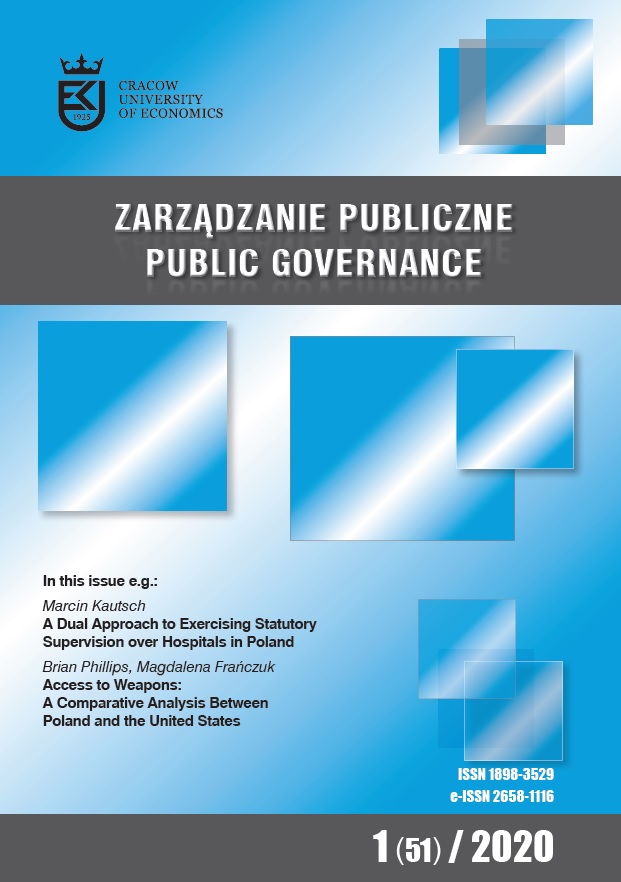The Analysis of Births and Household Poverty Levels with the Consideration of the Material Effect of the ‘Family 500 Plus’ Programme
DOI:
https://doi.org/10.15678/ZP.2020.51.1.02Keywords:
social policy, family policy, births, birthrate, povertyAbstract
Objectives: The objective of the article is to assess the performance of the Polish government’s family policy programme known as the ‘Family 500 Plus’ programme, with special consideration of the material effect. In this study, the authors attempt to assess the performance of the ‘ Family 500 Plus’ programme (Journal of Laws of 2016, item 195 as amended) in the first years of its operation, answering the question about whether the implementation of the government’s family policy programme has contributed to an increase in births and a decrease in the level of poverty in households in Poland.
Research Design & Methods: The authors conducted research on the chosen indicators, using the method of incomplete induction based on inductivism and verificationism. The study relies on the literature review and desk research. The analysis made use of statistical data provided by the Central Statistical Office (GUS). In the preparation of this article, legal acts placed on the Website of the Sejm of the Republic of Poland – as well as relevant scientific publications – were used.
Findings: Since the launch of the ‘Family 500 Plus’ programme, the number of births has clearly been gradually increasing. In the analysed period, we have laso observed positive birth changes within large families. The developmental trend of births showed an upward tendency in the first two years of the Act in force and changed in 2018. This clear change can be observed in the area of extreme poverty in households in 2015–2018. In households with at least two children up to the age of 18, there was a change in the extent of extreme poverty by almost 50%, which was approaching the extreme poverty line in a given year in Poland.
Implications & Recommendations: In view of the changes in trends in the number of births observed since 2018 as well as the extent of extreme poverty in households, the authors recommend further observation and analysis of the indicators presented in this study.
Contribution / Value Added: The presented analysis of the indicators and the observation of development trends will allow for a proper adjustment of family policy. In the future, this might make it easier for the public authorities to take appropriate decisions concerning family policy.
Article classification: research article
Downloads
References
Auleytner, J., & Głąbicka, K. (2000). Polityka społeczna pomiędzy opiekuńczością a pomocniczością. Wydawnictwo WSP TWP.
Drejer, F. (2011). Polityka rodzinna prowadzona w środowiskach lokalnych. Wychowanie w Rodzinie, 3, 244–245.
Durasiewicz, A. (2017). W kierunku rozwoju polityki rodzinnej w Polsce. Wyższa Szkoła Pedagogiczna im. Janusza Korczaka w Warszawie.
Głąbicka, K. (Ed.). (2009). Biuletyn Informacyjny, Wiadomości Społeczne. Polskie Towarzystwo Polityki Społecznej.
Statistics Poland. Terms used in official statistics. (http:/www.gus.gov.pl).
Statistics Poland. (2008). The Demographic Yearbook of Poland 2008. Warsaw, p. 294. (www.stat.gov.pl).
Statistics Poland. (2010). Branch Yearbooks, The Demographic Yearbook of Poland 2010. Warsaw, p. 266. (www.stat.gov.pl).
Statistics Poland. (2013). Branch Yearbooks, The Demographic Yearbook of Poland 2013. Warsaw, p. 289. (www.stat.gov.pl).
Statistics Poland. (2014). Branch Yearbooks, The Demographic Yearbook of Poland 2014. Warsaw, p. 305. (www.stat.gov.pl).
Statistics Poland. (2015). Branch Yearbooks, The Demographic Yearbook of Poland 2015. Warsaw, p. 267. (www.stat.gov.pl).
Statistics Poland. (2017). Branch Yearbooks, The Demographic Yearbook of Poland 2017. Warsaw, p. 258. (www.stat.gov.pl).
Statistics Poland. (2018). Branch Yearbooks, The Demographic Yearbook of Poland 2018. Warsaw, pp. 256, 261. (www.stat.gov.pl).
Statistics Poland. (2019). Branch Yearbooks, The Demographic Yearbook of Poland 2019. Warsaw, pp. 250, 255. (www.stat.gov.pl).
Statistics Poland. (2014). Households, Demographic characteristics, 2011 National Population and Housing Census. Warsaw, pp. 46, 47. (www.stat.gov.pl).
Statistics Poland. (2017). Poverty in Poland in 2015 and 2016, Statistical Publishing Establishment. Warsaw, pp. 9–12, 15. (www.stat.gov.pl).
Statistics Poland. (2018). Benefits for the family in 2018. Cracow, p. 5. (www.stat.gov.pl).
Statistics Poland. (2018). The range of extreme poverty in Poland in 2018. Warsaw, pp. 1, 5. (www.stat.gov.pl).
Statistics Poland. (2019). Concise Statistical Yearbook of Poland, Statistical Publishing Establishment. Warsaw, p. 156. (www.stat.gov.pl).
Statistics Poland. (2020). Statistical bulletin 03/2020. Rocznik Volume LXIV, Warsaw, p. 44. (www.stat.gov.pl).
Kotowska, I. E. (1999). Drugie przejście demograficzne i jego uwarunkowania. In Kotowska, I. E. (Ed.). Przemiany demograficzne w Polsce w latach 90. w świetle koncepcji drugiego przejścia demograficznego. Wydawnictwo AGH.
Kot, S. M. (2008). Polaryzacja ekonomiczna – teoria i zastosowanie. Wydawnictwo Naukowe PWN.
Kurzynowski, A. (1991). Problemy rodziny w polityce społecznej. Ośrodek Badań Społecznych.
Lipski, A. (1993). Ubóstwo poza sferą konieczności egzystencjalnej. In Frąckiewicz, L. (Ed.). Ubóstwo jako problem polityki społecznej. Wydawnictwo Uniwersytetu Ekonomicznego w Katowicach, pp. 27–34.
Lisiński, M. (2016). Procedury naukowe indukcji zupełnej i niezupełnej w metodologii nauk o zarządzaniu. Zeszyty Naukowe Uniwersytetu Ekonomicznego w Krakowie, 6(954), 23–46.
Maj-Waśniowska, K., & Stabryła, K. (2020). Wpływ wydatków budżetowych na zmniejszanie ubóstwa w Polsce. Zeszyty Naukowe SGGW w Warszawie: Polityki Europejskie, Finanse i Marketing, 23(72), 95–112.
Panek, T. (2011). Ubóstwo, wykluczenie społeczne i nierówności. Teoria i praktyka pomiaru. Oficyna Wydawnicza Szkoły Głównej Handlowej.
Slesicki, D. T. (1998). Empirical approaches to the measurement of welfare. Journal of Economic Literature, 36, 2108–2165. http://darp.lse.ac.uk/PapersDB/Slesnick_(JEL98).pdf (accessed: 20.09.2020).
Sobociński, M. (2016). Polska polityka rodzinna w latach 1989–2015. Próba podsumowania. Infos BAS, 8(212), 1.
Szulc, A. (2007). Dochód i konsumpcja. In Panek, T. (Ed.). Statystyka społeczna. Polskie Wydawnictwo Ekonomiczne, pp. 131–163.
Ulman, P., & Ćwiek, M. (2014). Ubóstwo gospodarstw domowych ze względu na ich typ biologiczny w ujęciu wielowymiarowym. Proceedings of the 8th Professor Aleksander Zelias International Conference on Modeling and Forecasting of Socio-
Economic Phenomena. https://www.pliki.konferencjazakopianska.pl/postępowanie_2014/pdf. Ulman_Cwiek.pdf (accessed: 20.09.2020).
The Act of February 11, 2016, on State Aid in Bringing Up Children (Journal of Laws of 2016, item 195, as amended). https://isap.sejm.gov.pl (accessed: 20.09.2020).
The Act of December 14, 2016, on Educational Law (Journal of Laws of 2020, item 910, consolidated text). https://isap.sejm.gov.pl (accessed: 20.09.2020).
Justification for the Bill on State Aid in Raising Children. https://legislacja.rcl.gov.pl/docs//2/12279566/12326791/12326792/dokument199001.pdf (accessed: 28.04.2020).



